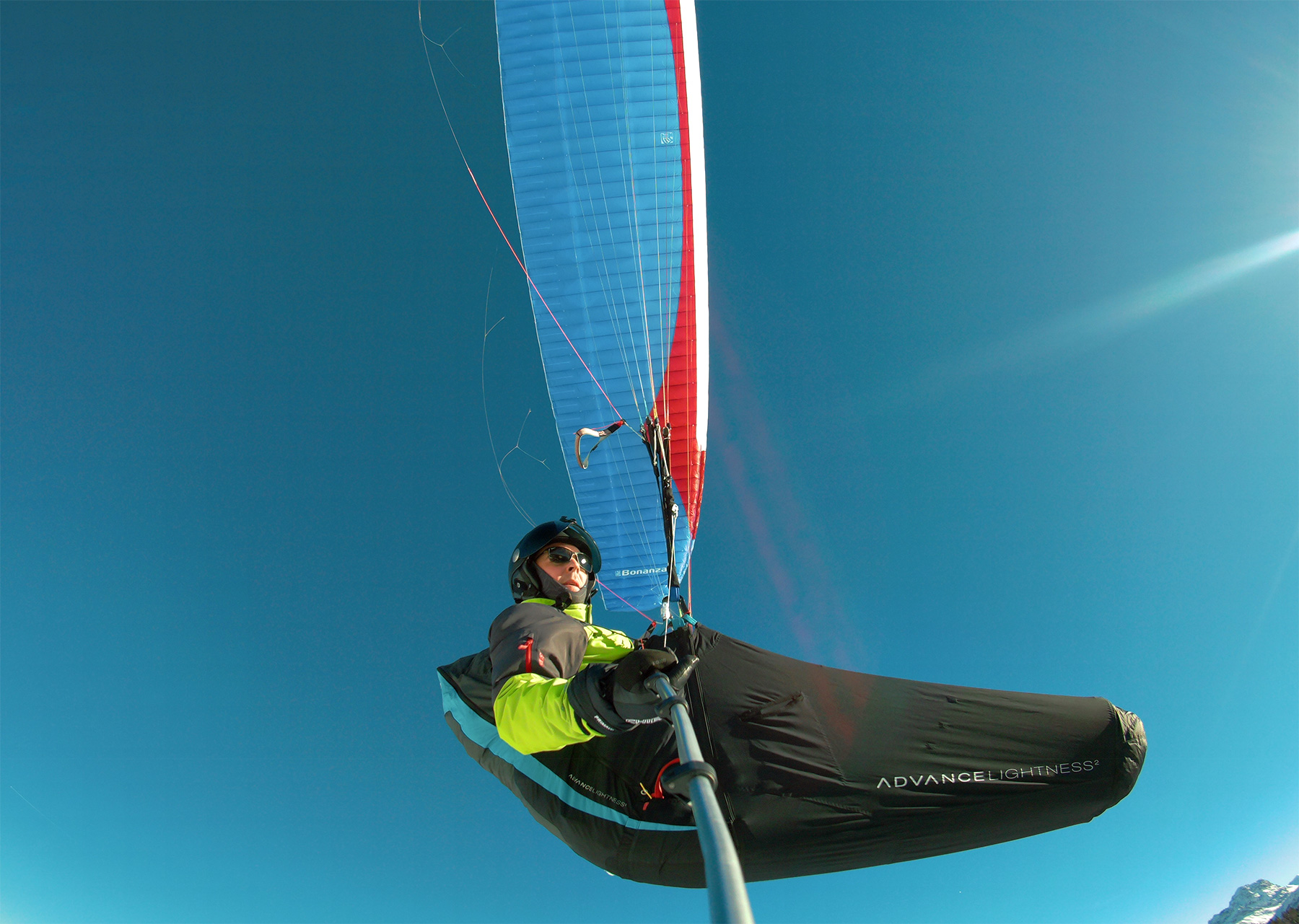After hearing positive things about the Australian newcomer Flow Paragliders (by Felipe Rendez), I was very curious about their new C-glider The Fusion to test. The concept of a hybrid 2-3-line liner sounded too interesting to resist a test. The XCRacer (2-liner EN D) has already stirred up the competitive market in 2018/19 for a short time and thus shifted the focus to the Australian manufacturer. Felipe originally comes from the kite scene, but as a competition pilot he is not a blank slate.
My Fusion Tester reached me last week, just before the big weather change. Therefore I had unfortunately only a short window between 2 fronts to test the wing. Too little height to test collapses and stalls. Size M (80-103kg) is suboptimal for my take off weight of 93kg. But that was clear from the front. Size S should also be available soon.
Test data
Paraglider: Flow Fusion size M (80-103kg), color Fire
Approval: EN C (mid C)
Take-off weight: 93kg total
Test area: Pfänder Bregenz
Conditions (total 1:40 airtime):
- 1. start max. 15km/h wind, no thermals.
- 2. start some crosswind, light dynamic thermals
- 3. start light tailwind, some thermals (2. test day)
- 4. start light tailwind, narrow, partly choppy thermals (2. test day)
General information
The Fusion is a so called hybrid 2-3-liner. This means that it has 3 line planes from the center of the wing to the outboard wing, but the outboard wings have only 2 planes (details can be found at Lucian). This is said to have saved 30m of line. The Fusion is said to have a 2-line-feeling. I can't say anything about that, because I have never flown a 2-line before. But after the first flights I can well imagine what is meant. Especially since a well-known XCRacer pilot said that the Fusion feels similar to the XCRacer. With its aspect ratio of 6.35 it is in the middle of the current C-Class. This is how it is praised. The Test protocol from Air Turquoise reads positively for a wing of this class.
The Sharknose of the Fusion is equipped with the orange (rather kink resistant) rods. In the upper sail, built of 68 cells, the rods continue to run until about 30cm before the trailing edge. But the rods are divided into 3 parts! So nose, upper wing part and lower wing part. This makes it possible to do without a roll when packing the sail, as the system is less sensitive to kinking.
The riser is in a class of its own! It is very elaborately designed to maintain an optimal profile over the rear plane of the C-Steering. The rear plane is equipped with light wooden handles for piloting and correcting in accelerated flight.
The line bundle per side is really extremely reduced! I have never seen anything like this on a 3-line - hybrid. The lines are all unsheathed, except in the lower part of the A and stabil lines. There they are highlighted in color.
The weight of size M is 4.65kg. I have not weighed it. The workmanship is very neat and all line suspension points are extra reinforced. The Fusion is produced in the same factory as the Airdesign gliders from Austria.
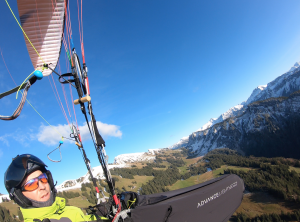
Start
My first start was at about 10km/h wind from the front. When pulled backwards the canopy rises slowly but surely to the zenith and does not tend to overshoot at all. The wing comes up cleanly and evenly and can then be stabilized in a relaxed manner. My second launch was in a light crosswind forward. Here too the fusion comes up evenly, slightly delayed. At the zenith it wants to be slowed down a bit. For a glider of this class an exemplary launch behavior.
Glide
For gliding I have to write my own paragraph. I didn't have an opponent, but I know at what height I usually come out at the pawnshop in 0 conditions. I have never reached this high before. In trim speed, which is extraordinarily high, it glides exceptionally well.
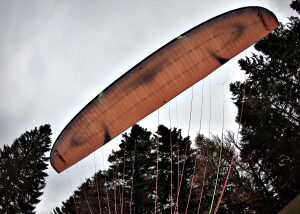
Flight feeling
In my opinion, the most important thing when flying is the feeling under a paraglider. If it is good, it contributes to fun and above all calmness. In Fusion, the feeling is something special. The canopy has an exceptionally high tension and acts like a cushioned board - in a positive sense. It is very well tensioned and feels extremely stable. The tension on the C-level is very high - I've never had such pressure on a glider before. This is probably also a part of the 2-line feeling. The Fusion stands stoically and very comfortably above the pilot. The damping over all axes is exceptionally high for this class and gives a safe and comfortable feeling. But a little at the expense of dynamics. I have to say the following: I have flown the Fusion under the medium weight range -> suboptimal. I like to fly at the upper limit or slightly above it and it is recommended to load the last quarter as well. In addition, the brakes have a slightly too high advance, also wound (I would shorten them by 5-6cm). This all contributes to the fact that the glider seems less agile. I will certainly find this out in size S (72 to 92kg). Let's face it: the Fusion is extremely comfortable to fly, but not the most agile. A classic flat twist. Personally, I don't think it's so bad, since I now place more value on relaxed flying.
Brake pressure
The pressure is above the middle range. At the first centimeters rather light, then rising. Since I flew only briefly in a slight climb, I can't say anything about a possible fatigue of the arms. The reaction on the brakes feels a bit muffled. Therefore I would definitely shorten them a bit or mount BrakeBalls.
C-Steering
By means of the wooden handles the rear plane can be used for steering and active flying in accelerated flight. However, the pressure is unusually high and you have to do some work to persuade the wing to turn. 2-line feeling? On my current Skywalk Spice the C plane is relatively easy to pull and on the Swift 5 it is almost negligently soft. Probably a matter of habit. That's what you have to get out of cross country flying.
Thermal Flying
I would describe my dynamic turns less as thermal flying. In this case I cannot say so much about it. The glider goes flat in the turns and feels very balanced and full. It nicely converts the turns into climbs. This is how circling is fun! In any case, the turns should be initiated with weight shifting.
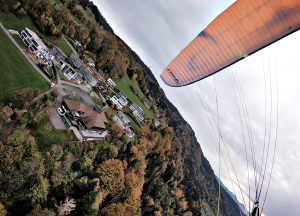
Put on ears
This works wonderfully over the outer A-lines. In order to get reasonably effective ears, the lines must be held as high up as possible. A brave pull is necessary to get the ears in. Once they are in, they will stay nice and stable. The opening is delayed when the ears are accelerated and you have to help to open them. If not accelerated, the ears will open again by themselves with a slight delay. The sinking values are in the average value.
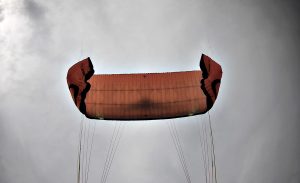
Dynamic
As already described, I can't make a final statement about this, because I loaded the glider under the middle and the brakes seemed to be too long. However, the Fusion does not seem to be a fun wing to hook. But it has a very comfortable damping and doesn't seem nervous in any way. A real carver. But I still hope that size S or the light version, which is scheduled for release in spring 2020, will have a little more dynamic.
Rattle
I have not tested it yet. Too little altitude, too short flight time. Possibly still possible on the weekend.
Landing
Der Fusion gleitet und gleitet… Landeplatz auf jeden Fall gut einteilen! 🙂 Ansonsten easy.
Conclusion
I think Flow Paragliders has achieved a special throw with the Fusion. I am personally impressed by the rich feeling under the fast wing. It feels like a lowered Porsche, yet with great suspension and comfort. How it performs in hard thermals and in everyday track conditions can only be roughly estimated. It has already convinced me so far that I will definitely test the size S. He is definitely something special. Designed down under.
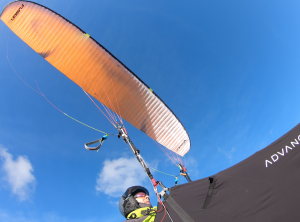
1. SUPPLEMENT:
Today, after about one hour of flight time, in case of thermal conditions the following addendum:
- I have retrofitted the brakes with my BrakeBalls .This allowed me to reach a few centimeters further up. The feeling to the glider is now a completely different one. The brakes grip very directly and the wing comes around corners very well. The working area is pleasantly short and linear.
- the thermals were not really strong, but partly stubborn and very narrow. The Fusion takes all this comfortably and gives a good feedback. It pulls nicely into the thermals and bites itself cleanly into them when flying in (brake input necessary).
- the steering with the special grips in accelerated flight works very well The wing does not even deform the profile. The solution of the riser is well thought out!
- 2 more forward launches in light tailwind: folds reliably and even better if you only grab the inner A-lines above the line buckle. It's a bit tricky because the A-lines on the riser are hardly separated.
Size S SUPPLEMENT:
I have now flown size S several times compared to size M. At the top loaded (93kg) it is much more dynamic and goes around corners very well! I could not find a disadvantage concerning the smaller surface.

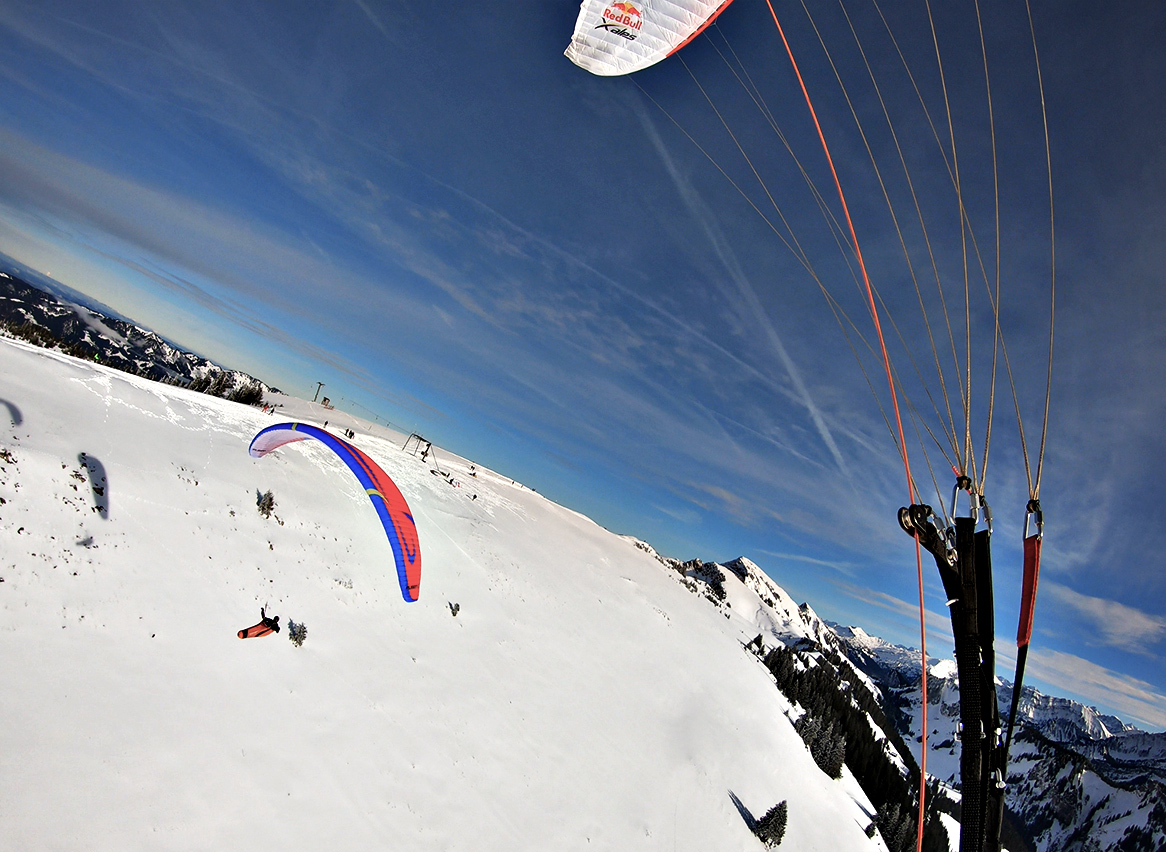
Lust zum Testen? http://www.flowgleitschirme.de
Gebrauchte Gleitschirme gibt es auf Para-Markt.com

